|
|
|
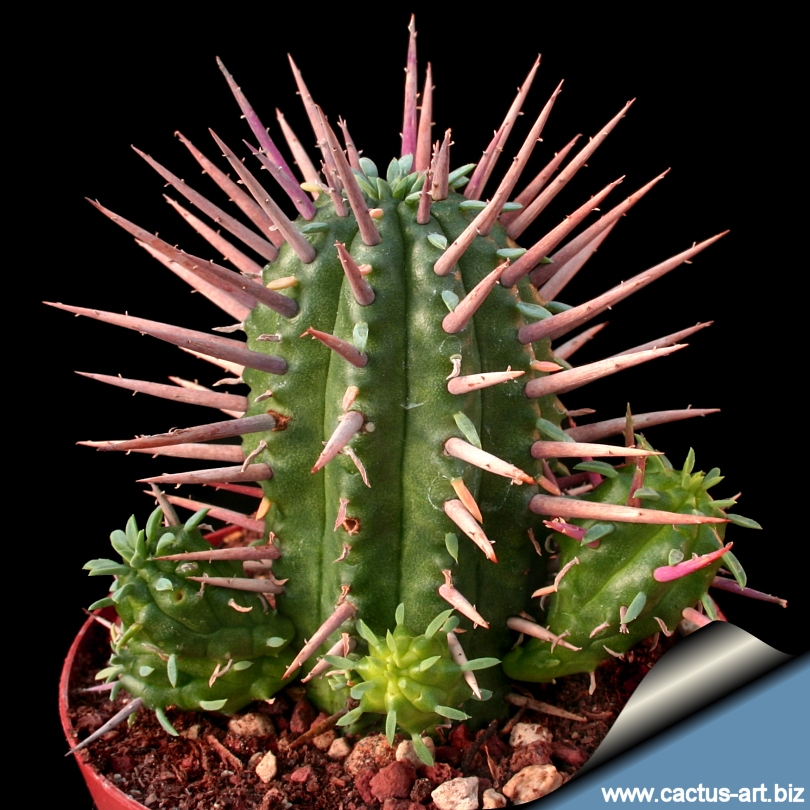
Euphorbia ferox (Giant form) has fantastic purple spines
and offsets freely to produce a beautiful mounded plant.
|
Decription: Small spiny succulent shrublet branching at the base,
it will form rounded clusters up to 60 cm in diameter.
Stem: It has columnar spiny succulent green
stems, about 5 cm in
diameter. The stem looks like a green corncob with thorns.
Ribs are
linear with minimal cross-channels.
Leaves: Tiny,
ephemerals.
Spines: The spines are indeed solitary sterile
peduncles. They are very numerous, about 6 mm apart, stout, spiny
rigid, 1-6 cm straight , reddish turning purple and finally
grey.
|
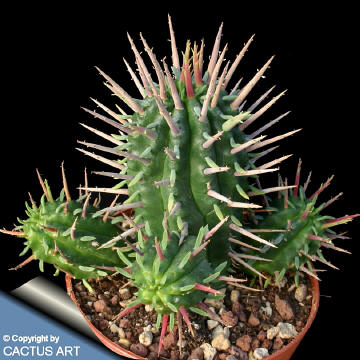 |
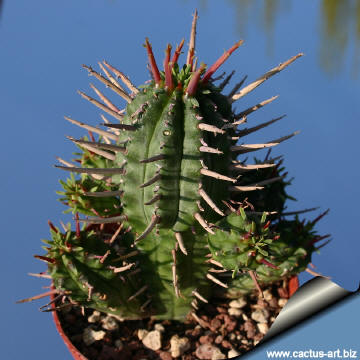
|
|
Note: Euphorbia ferox has a large area of distribution and
is a very variable species. The difference between populations is the
frequency of the appearance in which these forms do occur. So it is
possible that two individuals of two different populations can look very
similar and also, that two plants of the same population can look very
different. However when you are looking at the whole population, you can
see the difference between one population and another.
E. ferox belongs to Euphorbia section
19, along with E. aggregata, mammillaris, anoplia, enopla, heptagona,
pentagona and polygona which are all similar in
form. In particular,
E. ferox looks a lot like
E. enopla, but E. ferox is much fatter.
|
|
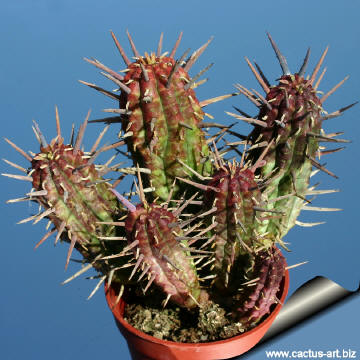
Winter |
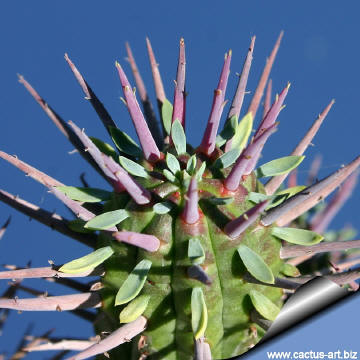
Summer |
|
 |
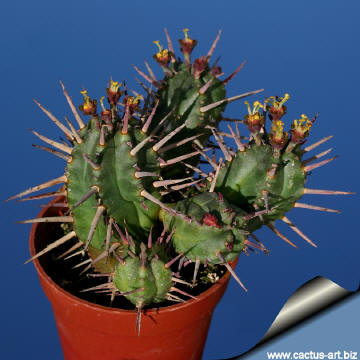 |
|
Propagation: It is propagated by cuttings (It branches
enthusiastically, and offsets are readily available). If you remove an
offset, remember to let it dry for a week or so, letting the wound heal
(cuttings planted too soon easily rot before they can grow roots). It is
better to wash the cut to remove the latex.
Warning: As with all other Euphorbias when a plant get damaged it
exudes a thick white milky sap known as latex. This latex is poisonous,
and may irritate skin. Pay extreme attention not to get any in your
eyes or mouth.
Cultivated plants must be handled carefully.
|
|
Photo of conspecific taxa, varieties, forms and
cultivars of Euphorbia ferox.
Advertising
|
|
|
|
|
Family: Euphorbiaceae
Scientific name: Euphorbia
ferox
Described by Dr. Marloth in 1913
Introduction:
Euphorbia ferox
belongs to a group of plants, together with the closely related species
Euphorbia pulvinata and Euphorbia aggregata,
which can be recognised by their striking growing-shape. They
consist
mostly of compact, multiple-branched and heavily-thorned cushions. These
species are closely related, and for an outsider it's very difficult to
distinguish them. There are differences though. The english nickname
"pincushion" says enough.
Origin: South Africa, Great Karoo area (the distribution-area
starts in the east around Graaff Reinet, and from there to the west until
Beaufort West. )
Habitat: At some locations it is the most
dominant vegetation, often growing together with Euphorbia esculenta and
Euphorbia mammillaris.
Conservation status: Listed in
CITES appendix 2.
Common Name: Pincushion Euphorbia
Synonyms: Euphorbia caespitosa
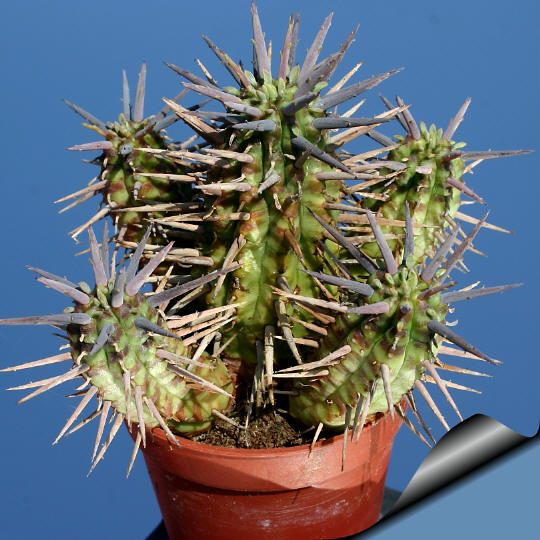
|
|
|
|
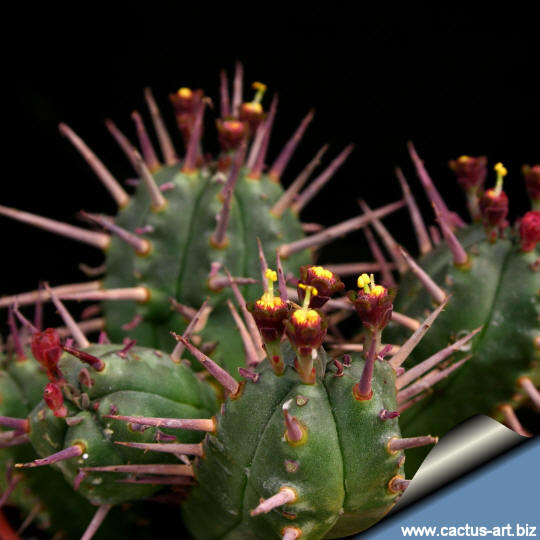
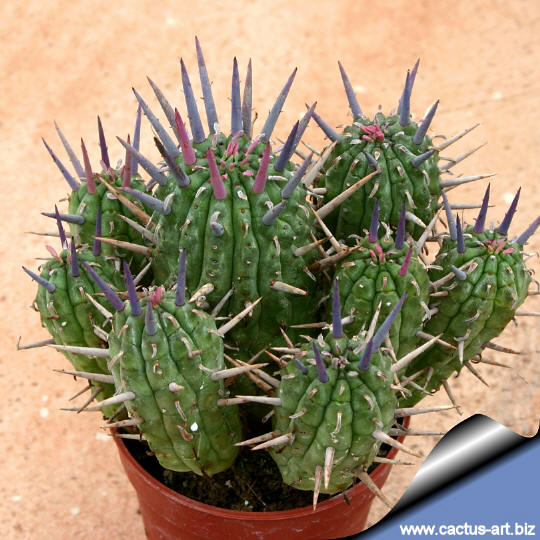
Cultivation:
Common and easy to grow plant for pot culture. It grows well in a very
draining mineral potting substrate, but it isn't picky about soil. The
area to which this plant is native receives rains in both winter and
summer, so it can be watered moderately all year around (except in the
coldest month of the winter, as it rots easily, especially if overly
wet). During the summer they enjoy average feeding and watering. When
dormant in winter, keep it totally dry at or around 4°C, even though it
seems to tolerate light frosts well. Mature healthy plants are tough
and can also be grown out-of-doors where frost is not too severe, but
when left out it is more sensitive to frost. They do need a lot of
light to keep their compact growth-form, but different clones vary in
their tolerance of full sunshine. But best colour if grown in protection
in light shade, where the thick purple spines of this low-growing
clumping columnar plant have the best colour. Sometimes, in really hot
full sun all day long, a plant will bleach out a bit

 |
|